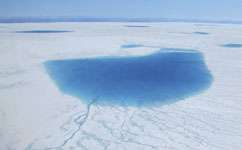Accurate forecasts of Arctic summer sea ice one step closer

Scientists can now forecast how much sea ice will cover the Arctic at the end of the summer by measuring the area covered by ponds of water on the ice in spring.
The findings, published in Nature Climate Change are good news for those who urgently need accurate forecasts of Arctic summer sea-ice extents, such as shipping and oil and gas extraction companies.
But they're not such good news for anyone interested in how climate change is affecting the Arctic.
Dr David Schröder and colleagues from the University of Reading report in their study that the ponds absorb the sun's rays. This warms the ice up, leading to more melting and ultimately, bigger ponds.
'We've known for some time that low reflectivity is likely to lead to a positive feedback effect. So, more ponds reduce albedo – or reflectivity; lower albedo causes more melting; and more melting causes more ponds. But we were surprised at how clear the link between this and late summer sea-ice extent is,' says Schröder.
The area of the Arctic covered by sea ice at the end of summer has dropped from around seven million km2 in the 1990s to less than five million in five of the past seven years.
In September 2012, it reached a record low of just 3.6 million km2. While these figures are startling by most people's standards, the speed of the decrease has taken even researchers by surprise.
Over the last two decades, scientists have noticed growing numbers of so-called meltponds on Arctic sea ice. But until now it wasn't clear if and how these ponds were linked to late summer sea-ice extent.
Schröder and his colleagues developed a computer model suitable for forecasting how meltponds evolve. Based on a 35-year long simulation, they found that ponds start forming in May, peak by mid-July, and have mostly disappeared by mid-August.
They also discovered that in 1996, the year when sea-ice coverage in the Arctic reached its highest level since the 70s, the area covered by ponds only reached 11 per cent. In contrast, in the July before the 2012 record sea-ice extent minimum, meltponds covered 34 per cent.
'Our results confirm that the early melt season is decisive for the strength of the summer ice retreat. We can now include this process in climate models, which is likely to make them that much more accurate,' adds Schröder.
The researchers admit that it's impossible to forecast September ice extent from spring meltpond area perfectly, because summer weather and Arctic Ocean circulations also play a role.
Schröder also says that right now, they can't provide forecasts for September ice extent for different regions of the Arctic.
But when they used their model to estimate the September 2013 sea-ice extent, their figure of 5.55 million km2 was much closer to the actual figure of 5.35 million km2 than all 23 predictions presented on the Arctic Sea Ice Outlook webpage in July 2013.
'Including our model in climate models promises to improve the prediction of Arctic September ice extent substantially. We're now looking forward to using meltpond data from May 2014 to estimate September 2014 sea-ice extent,' says Schröder.
More information: David Schröder, Daniel L. Feltham, Daniela Flocco & Michel Tsamados, "September Arctic sea-ice minimum predicted by spring melt-pond fraction," Nature Climate Change, 4, 353-357 (2014), published online 20 April 2014, DOI: 10.1038/nclimate2203
Journal information: Nature Climate Change
Provided by PlanetEarth Online
This story is republished courtesy of Planet Earth online, a free, companion website to the award-winning magazine Planet Earth published and funded by the Natural Environment Research Council (NERC).



















